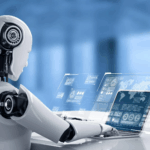Climate change is one of the most pressing challenges of the 21st century, threatening ecosystems, economies, and communities worldwide. Rising global temperatures, extreme weather events, biodiversity loss, and growing carbon emissions underscore the urgent need for innovative strategies. Traditional methods of mitigation and adaptation, while crucial, are not enough to match the scale and speed of the crisis.
This is where AI climate change solutions are stepping in as a transformative force. By harnessing the power of machine learning, predictive modelling, and advanced data analytics, artificial intelligence is enabling scientists, policymakers, and businesses to respond more effectively to climate challenges. From optimising renewable energy systems to predicting natural disasters and monitoring deforestation, AI is becoming a vital tool in the global fight against climate change.
In this article, we explore the many ways AI is reshaping climate action — and why it may be one of humanity’s best chances at creating a sustainable future.
The Role of AI in Fighting Climate Change
Artificial intelligence is uniquely positioned to help combat climate change because of its ability to process vast datasets, identify patterns, and make accurate predictions at scale. These capabilities make it a critical enabler for governments, organisations, and industries seeking to transition toward sustainability.
1. AI for Climate Prediction and Modelling
Traditional climate models are complex and resource-intensive. With AI, scientists can:
- Analyse decades of climate data in seconds.
- Predict long-term environmental changes with higher accuracy.
- Simulate the impact of different policy or industrial decisions on global warming.
For example, AI-driven models can forecast the likelihood of droughts, floods, or hurricanes weeks in advance, giving communities more time to prepare.
2. AI for Resource Efficiency
AI helps reduce waste and optimise resource usage in industries such as energy, agriculture, and manufacturing.
- In agriculture, AI algorithms determine the precise amount of water or fertiliser crops need, reducing overuse and lowering emissions.
- In manufacturing, predictive maintenance powered by AI ensures machinery runs efficiently, cutting unnecessary energy consumption.
3. AI for Environmental Monitoring
AI systems paired with satellite imagery and IoT sensors can:
- Detect illegal logging in real time.
- Monitor ice sheet melting and ocean temperature changes.
- Track air pollution levels in urban areas.
This real-time monitoring helps governments and organisations respond quickly to environmental threats.
4. AI for Renewable Energy Management
Renewable energy is a cornerstone of climate action, but wind and solar power are inherently variable. AI mitigates this challenge by:
- Predicting solar and wind energy output.
- Managing grid loads to balance supply and demand.
- Automating smart grids to reduce energy waste.
As a result, renewable energy becomes more reliable and scalable.
AI in Renewable Energy Solutions
Renewable energy is essential to addressing the climate crisis, but solar and wind energy face a common challenge: variability. Weather conditions change daily, and without accurate predictions, power grids struggle to balance supply and demand. This is where AI climate change solutions are proving transformative, ensuring renewables can scale reliably and sustainably.
AI for Solar Energy
Solar power has immense potential but is heavily dependent on weather conditions. AI technologies help by:
- Forecasting Solar Output: AI models analyse historical data, satellite imagery, and weather patterns to predict solar energy generation with high accuracy.
- Optimising Panel Efficiency: AI-powered monitoring systems detect dirt, shading, or technical faults on panels and recommend cleaning or adjustments.
- Smart Deployment: Machine learning can determine the best placement for solar panels to maximise sunlight exposure in urban and rural environments.
Example: Google’s DeepMind has successfully used AI to predict solar energy output up to 36 hours in advance, allowing grid operators to plan more effectively.
AI for Wind Energy
Like solar, wind energy depends on fluctuating natural conditions. AI enables more stable integration of wind power into national grids by:
- Predicting Wind Patterns: Machine learning algorithms model complex atmospheric data to forecast wind speeds and directions.
- Turbine Optimisation: AI systems adjust the angle and rotation of turbines in real time to capture maximum energy.
- Predictive Maintenance: AI detects early signs of wear and tear, reducing costly downtime.
Example: Siemens Gamesa uses AI-driven predictive maintenance to extend the lifespan of wind turbines and minimise failures.
AI for Smart Energy Grids
Smart grids represent the future of sustainable energy, where AI plays a central role in balancing renewable supply and consumer demand.
- Load Forecasting: AI predicts energy demand spikes, ensuring that supply meets consumption without overloading systems.
- Energy Storage Optimisation: AI determines when to store surplus energy in batteries and when to release it to the grid.
- Reducing Waste: Automated grid adjustments prevent unnecessary power losses.
Example: In Europe, AI-powered smart grids have improved renewable integration, reducing reliance on fossil fuels during peak hours.
Why This Matters
By integrating AI into solar, wind, and smart grid management, renewable energy becomes:
- More reliable — reducing blackouts and variability issues.
- More affordable — through predictive maintenance and efficiency gains.
- More scalable — enabling higher adoption rates worldwide.
These AI climate change solutions prove that artificial intelligence isn’t just a support tool; it is a driving force in making renewable energy the backbone of a sustainable future.
AI for Environmental Monitoring & Conservation
One of the greatest strengths of AI climate change solutions is their ability to analyse vast amounts of environmental data in real time. Traditional monitoring methods are often slow, expensive, and limited in scale. With the help of artificial intelligence, governments, NGOs, and research institutions can now track environmental threats more accurately and respond faster.
AI in Deforestation Tracking
Deforestation is a major contributor to climate change, releasing stored carbon dioxide into the atmosphere and reducing the Earth’s capacity to absorb emissions. AI tools are making it easier to:
- Analyse Satellite Imagery: Machine learning models scan high-resolution satellite images to detect illegal logging or forest fires.
- Real-Time Alerts: Systems like Global Forest Watch use AI to send alerts when new deforestation activity is detected.
- Policy Enforcement: Governments can use AI data to strengthen enforcement against illegal activities in remote areas.
Example: Microsoft’s AI for Earth program has partnered with conservation groups to identify deforestation hotspots and guide protective policies.
AI in Wildlife Protection
Biodiversity loss is accelerating due to poaching, habitat destruction, and climate change. AI-powered monitoring systems are transforming wildlife conservation:
- Poaching Prediction: AI models analyse historical poaching incidents to predict where illegal activity might occur.
- Camera Trap Analysis: Machine vision can process thousands of camera trap images to identify species and track their populations.
- Acoustic Monitoring: AI detects sounds of endangered species (such as whales or elephants) or unusual gunfire activity in protected zones.
Example: Conservation AI has deployed AI-powered camera traps in African reserves to track elephants and alert rangers about poaching threats in real time.
AI for Climate Data Analytics
Climate science relies on vast amounts of complex data — from atmospheric CO₂ levels to ocean temperature readings. AI is now used to:
- Predict Natural Disasters: Machine learning models can forecast hurricanes, floods, and droughts with greater accuracy.
- Climate Simulations: AI reduces the time required to run climate models, accelerating research.
- Urban Planning: AI-driven heat maps guide policymakers in building greener, more resilient cities.
Example: IBM’s Green Horizons project uses AI to predict air pollution and provide real-time air quality forecasts in major cities worldwide.
Why This Matters
Environmental monitoring and conservation are essential pillars of climate action. AI allows us to:
- Detect and respond to ecological threats faster.
- Protect endangered species with precision.
- Make more informed policy and business decisions.
By scaling real-time environmental monitoring, AI climate change solutions ensure that ecosystems and biodiversity — vital to balancing the Earth’s climate — are better preserved for future generations.
AI for Sustainable Agriculture
Agriculture accounts for nearly one-third of global greenhouse gas emissions, making it both a driver of climate change and a sector highly vulnerable to its impacts. Rising temperatures, unpredictable rainfall, and soil degradation are already threatening food security worldwide. Artificial intelligence offers powerful solutions through precision farming, smarter supply chains, and carbon reduction strategies.
Precision Farming with AI
Precision farming, powered by AI, ensures that every input — water, fertiliser, pesticides — is used efficiently and only when needed.
- Smart Irrigation Systems: AI algorithms analyse soil moisture, weather forecasts, and crop needs to automate irrigation schedules. This reduces water waste in drought-prone regions.
- Fertiliser Optimisation: Machine learning models predict nutrient deficiencies and recommend precise dosages, reducing overuse that leads to emissions and water pollution.
- Crop Yield Prediction: AI analysis satellite data and historical records to forecast yields, helping farmers plan better and reduce waste.
Example: John Deere has integrated AI-powered sensors and computer vision into farm machinery to distinguish between crops and weeds, enabling targeted pesticide use and lowering chemical emissions.
Reducing Carbon Footprint in Farming
Beyond yield optimisation, AI helps reduce agriculture’s carbon footprint by transforming how crops are grown, harvested, and transported.
- Supply Chain Optimisation: AI logistics platforms reduce food miles by matching demand and supply locally, cutting fuel emissions.
- Carbon Sequestration Monitoring: AI models assess how much carbon is stored in soil and vegetation, guiding climate-smart farming practices.
- Livestock Monitoring: AI tools track animal health, feeding patterns, and methane emissions, helping farmers lower livestock-related emissions.
Example: The startup PEAT’s Plantix app uses AI image recognition to help farmers detect plant diseases early, reducing crop losses and unnecessary pesticide applications.
Why This Matters
Agriculture is at the intersection of food security and climate action. By applying AI climate change solutions in farming, we can:
- Increase productivity while conserving resources.
- Reduce emissions from fertilisers, pesticides, and livestock.
- Build more resilient food systems in the face of climate change.
In short, AI transforms agriculture into a sector that is not only more efficient but also more sustainable, ensuring that the world can feed a growing population without worsening the climate crisis.
AI in Carbon Capture and Emissions Reduction
Carbon dioxide (CO₂) emissions are the leading driver of global warming, and reducing them is a top priority for climate policy and technology. While renewable energy helps prevent future emissions, we also need solutions to capture existing carbon and monitor industries more effectively. Artificial intelligence is now playing a pivotal role in scaling carbon capture and cutting emissions across multiple sectors.
AI in Carbon Capture Technologies
Carbon capture and storage (CCS) technologies are complex and expensive, but AI makes them more effective by:
- Optimising Capture Processes: Machine learning algorithms adjust temperature and pressure in capture facilities to increase efficiency.
- Predicting Storage Stability: AI models simulate geological conditions to ensure CO₂ stored underground remains secure over decades.
- Cost Reduction: AI-driven simulations reduce the need for trial-and-error, lowering operational costs of CCS plants.
Example: Researchers at MIT are using AI-powered modelling to predict the best geological formations for long-term carbon storage, minimising leakage risks.
AI in Industrial Emissions Monitoring
Industries such as steel, cement, and oil & gas account for a large share of global emissions. AI enables precise monitoring and reduction by:
- Real-Time Emission Tracking: Sensors feed data into AI systems that monitor CO₂, methane, and other pollutants continuously.
- Predictive Maintenance: AI predicts equipment failures that could cause emission spikes, allowing preventive action.
- Process Optimisation: Machine learning fine-tunes industrial operations to minimise fuel use and waste.
Example: Shell has implemented AI-based monitoring to track methane leaks in its natural gas facilities, reducing both emissions and financial loss.
AI in Carbon Offset Strategies
Carbon offsetting is often criticised for lack of transparency, but AI improves credibility by:
- Verifying Offsets: AI analyses satellite imagery of forests and wetlands to confirm that offset projects actually sequester carbon.
- Dynamic Tracking: Machine learning continuously monitors offset projects for compliance over time.
- Market Optimisation: AI helps organisations choose the most cost-effective and impactful offset initiatives.
Example: Pachama, a climate-tech startup, uses AI and satellite data to verify the effectiveness of reforestation carbon offset projects, increasing accountability in carbon markets.
Why This Matters
Carbon capture and emission reduction are non-negotiable for meeting global climate goals. With AI integration:
- Capture systems become more efficient and affordable.
- Industrial emissions are monitored with unprecedented precision.
- Carbon offset projects gain transparency and trust.
Together, these AI climate change solutions ensure that emission reductions move from policy aspirations to measurable impact.
Case Studies: How AI is Already Making a Difference
While much of the discussion around AI climate change solutions focuses on potential, there are already powerful examples of AI making measurable impacts in the real world. Leading corporations and research initiatives have deployed AI to reduce emissions, improve energy efficiency, and advance environmental monitoring.
Google DeepMind: Reducing Data Centre Energy Use
Data centres consume vast amounts of electricity, contributing significantly to carbon emissions. Google’s DeepMind applied AI to optimise cooling systems in its data centres, reducing energy usage for cooling by up to 40%.
- How it Works: Machine learning algorithms monitor thousands of sensors across the facility and adjust cooling systems in real time.
- Impact: This has lowered Google’s overall energy footprint and set a benchmark for energy efficiency in tech infrastructure.
- Broader Implication: Similar AI-driven optimisation can be applied to industrial plants, office buildings, and smart cities worldwide.
Microsoft AI for Earth: Conservation and Agriculture
Microsoft launched AI for Earth, a global programme funding projects that use artificial intelligence to tackle environmental challenges.
- Focus Areas: Agriculture, biodiversity, climate change, and water.
- Applications:
- AI models predicting agricultural yields to improve food security.
- AI-powered satellite imagery detecting illegal deforestation.
- Climate data analytics supporting adaptation strategies.
- Impact: Microsoft has provided grants and AI resources to thousands of NGOs, startups, and researchers globally.
IBM Green Horizons: Climate & Pollution Forecasting
IBM’s Green Horizons initiative leverages AI and big data to predict air pollution, improve renewable integration, and help cities plan for climate resilience.
- Pollution Modelling: AI forecasts city-level air quality days in advance, allowing governments to issue alerts and take preventive action.
- Renewable Energy Forecasting: AI models predict wind and solar output to ensure smoother integration into the grid.
- Urban Planning: Provides city leaders with AI insights to design greener, more sustainable urban environments.
Why These Case Studies Matter
These initiatives highlight how AI climate change solutions are already producing tangible results:
- Lowering emissions in high-energy industries.
- Supporting conservation and biodiversity protection.
- Making cities smarter and more climate resilient.
They demonstrate that AI is not just theoretical — it is an actionable, scalable tool already being applied to some of the world’s most urgent environmental challenges.
Challenges & Limitations of AI in Climate Change Solutions
While AI climate change solutions hold transformative potential, there are still major challenges that limit their effectiveness. A balanced understanding of these issues is critical for businesses, policymakers, and researchers.
1. High Energy Consumption of AI Models
Training large AI models requires enormous computing power, which itself consumes significant electricity. If this energy comes from fossil fuels, AI could contribute to the very problem it seeks to solve.
Example: Training a single advanced AI model can generate as much carbon as the lifetime emissions of several cars.
2. Data Availability and Accessibility
AI thrives on data, but reliable climate and environmental datasets are often:
- Incomplete in developing regions.
- Fragmented across multiple agencies and institutions.
- Proprietary, making them inaccessible for public research.
Without high-quality data, AI predictions and models risk being inaccurate.
3. Economic and Social Barriers
- Advanced AI platforms like Brandwatch, Sprout Social, or carbon capture AI systems can cost thousands of dollars monthly, making them inaccessible for small nations, NGOs, or grassroots movements.
- Rural and underfunded regions, which face the worst climate impacts, may lack the infrastructure to deploy AI effectively.
4. Over-Reliance on Technology
While AI is powerful, it cannot replace policy action, corporate responsibility, and human behaviour change.
- Governments still need strong climate regulations.
- Businesses must adopt sustainable practices.
- Citizens must change consumption patterns.
Takeaway: AI is an enabler, not a silver bullet.
5. Ethical and Governance Challenges
- Bias in AI Models: Poorly designed models may prioritise certain geographies or industries, leaving others behind.
- Accountability Issues: If an AI-driven climate model fails, who is responsible?
- Transparency Concerns: Many AI tools are “black boxes,” making it hard for policymakers to trust their outputs.
6. Uneven Global Deployment
Wealthier nations and corporations are leading the adoption of AI climate solutions. Meanwhile, developing countries — where climate change is often most severe — may be excluded from these advancements due to financial, technical, and political constraints.
Why These Challenges Matter
For AI to truly deliver on its promise in climate action, stakeholders must:
- Transition AI computing to renewable energy.
- Improve open access to environmental datasets.
- Build equitable access for vulnerable regions.
- Establish global governance for ethical AI use in climate change.
The Future of AI Climate Change Solutions
The next decade will be decisive in humanity’s fight against climate change, and artificial intelligence will play a central role. While today’s applications are already impactful, the future promises even greater advances as AI becomes more powerful, accessible, and integrated into global sustainability strategies.
1. Predictive Climate Modelling with Next-Gen AI
- What’s coming: More accurate simulations of climate systems using large-scale AI models.
- Why it matters: These models will not only forecast extreme weather but also simulate the impact of policy changes, deforestation rates, or renewable adoption scenarios.
- Potential: Governments could use AI-driven predictions to design smarter, data-backed climate policies.
2. AI + IoT in Smart Cities
- What’s coming: Integration of AI with the Internet of Things (IoT) to create cities that automatically minimise their carbon footprint.
- Examples:
- AI traffic systems reducing congestion and fuel use.
- Smart energy grids dynamically balancing renewable supply and demand.
- Buildings using AI to adjust heating, cooling, and lighting automatically.
- Potential: Entire urban areas could run on self-optimised systems that conserve energy and cut emissions.
3. Breakthroughs in AI-Powered Renewable Energy
- What’s coming: AI will help renewable systems achieve near-perfect efficiency.
- Examples:
- AI batteries that self-optimise charging and discharging cycles.
- Wind and solar farms that adapt in real time to environmental conditions.
- Potential: Renewables may fully replace fossil fuels faster than current projections.
4. AI for Global Climate Collaboration
- What’s coming: AI platforms enabling countries, NGOs, and corporations to share data securely and collaborate in real time.
- Why it matters: Climate change is a global issue — AI-driven platforms could provide a single source of truth for decision-making worldwide.
- Potential: Cross-border solutions for emissions tracking, resource allocation, and conservation.
5. AI in Carbon Removal & Geoengineering
- What’s coming: Smarter AI-guided carbon capture, reforestation, and even controversial geoengineering projects.
- Examples:
- AI drones planting trees at scale in deforested regions.
- AI-guided ocean fertilisation or solar reflection research.
- Potential: These technologies could buy time while longer-term transitions to net zero take hold.
6. Democratisation of AI Climate Solutions
- What’s coming: Open-source AI tools for farmers, local governments, and small NGOs.
- Why it matters: Most vulnerable communities currently lack access to advanced tech.
- Potential: AI could empower grassroots climate resilience, ensuring solutions reach beyond wealthy nations.
Why the Future Looks Promising
The future of AI climate change solutions will be defined by collaboration between technology, policy, and human behaviour. While challenges remain, the potential of AI to reshape energy, agriculture, conservation, and carbon removal gives humanity a fighting chance to mitigate the climate crisis.
FAQs About AI Climate Change Solutions
1. How can AI help fight climate change?
AI helps by improving climate modelling, optimising renewable energy systems, reducing industrial emissions, monitoring deforestation, supporting sustainable farming, and predicting natural disasters. These AI climate change solutions make mitigation and adaptation strategies more effective.
2. Can AI predict climate change impacts?
Yes ✅. Machine learning models can process decades of climate data to predict temperature rises, sea-level changes, and extreme weather events. This allows policymakers and communities to prepare more effectively.
3. How does AI improve renewable energy?
AI increases the efficiency of solar and wind power by:
- Predicting energy generation from weather data.
- Balancing demand and supply on smart grids.
- Reducing energy waste through predictive analytics.
4. Is AI sustainable given its own energy use?
AI models consume significant computing power, which raises concerns. However, many companies are shifting to renewable-powered data centres. Moreover, the emissions saved through AI-powered efficiency gains often outweigh its energy costs.
5. What are some real-world examples of AI climate change solutions?
- Google DeepMind reduced data centre cooling energy by 40%.
- Microsoft AI for Earth supports conservation and agriculture projects.
- IBM Green Horizons predicts urban air pollution and renewable integration.
6. How is AI used in agriculture for climate solutions?
AI supports precision farming with smart irrigation, fertiliser optimisation, and yield forecasting. It also helps track carbon sequestration in soil and reduces food waste through smarter supply chains.
7. Can AI help reduce carbon emissions?
Yes. AI optimises industrial processes, predicts equipment failures, and improves carbon capture technologies. It also verifies carbon offset projects using satellite imagery.
8. Is AI used in wildlife and biodiversity protection?
Yes ✅. AI camera traps and acoustic sensors monitor species, predict poaching risks, and analyse migration patterns. This helps conservationists protect biodiversity — a critical factor in maintaining climate stability.
9. Which companies are leading in AI climate change solutions?
Tech giants such as Google, Microsoft, and IBM are leading global initiatives. Climate-tech startups like Pachama (carbon offsets) and PEAT (agriculture AI) are also innovating in niche sectors.
10. Will AI alone solve climate change?
No ❌. AI is a powerful enabler but cannot replace human action, strong policies, and behavioural changes. It works best as part of a holistic approach combining renewable energy, sustainable practices, and international cooperation.
Conclusion
The fight against climate change demands urgent, innovative, and scalable solutions. Artificial intelligence has proven itself as a powerful ally in this mission, transforming how we generate energy, monitor ecosystems, protect biodiversity, reduce emissions, and design sustainable cities.
Through AI climate change solutions, we now have the ability to:
- Optimise renewable energy systems like solar and wind.
- Forecast extreme weather and predict climate impacts.
- Monitor deforestation, protect endangered species, and conserve biodiversity.
- Enable sustainable farming and reduce food waste.
- Advance carbon capture, storage, and offset strategies.
From Google DeepMind’s energy-efficient data centres to Microsoft’s AI for Earth initiative and IBM’s Green Horizons project, real-world examples show that AI is already making a measurable difference. Looking ahead, the integration of AI with IoT, smart cities, and global climate policy will open new frontiers in climate action.
Yet, it is important to acknowledge that AI is not a silver bullet. Challenges such as high energy consumption, limited access to reliable data, and ethical governance remain. The true power of AI lies in combining its capabilities with human creativity, strong policy frameworks, and collective action.
The path forward is clear: embracing AI not as a replacement for human effort, but as a force multiplier that enhances global climate strategies.
👉 If you want to explore more insights into how artificial intelligence is shaping our future, visit AI of the Decade — your trusted source for the latest in AI innovation.











